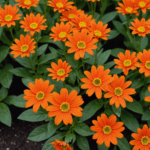The Bourvreuil: A Shy Bird with a Scarlet Belly
The bourvreuil, scientifically known as Pyrrhula pyrrhula, belongs to the Fringillidae family of small to medium-sized passerine birds. With nine distinct subspecies, this timid and discreet bird is primarily seen in parks and gardens during winter when it gathers with other members of its species to search for food. Let’s dive into the world of this beautiful red-breasted passerine bird.
Who is the Bourvreuil Pivoine?
The bourvreuil pivoine is a bird that measures about 16 cm in length with a wingspan of 28 cm and weighs between 26 g and 38 g. Its distinctive plumage sets it apart from other birds; the male bourvreuil has cheeks, a throat, breast, and belly with a lovely reddish-orange hue. However, its mantle, back, and wings are light gray. The head and tail feathers are shiny black, while the rump is white.
The female bourvreuil and juveniles have more muted colors, with a gray-brown mantle and no black cap. Their plumage has more reddish tones.
The bourvreuil has a black conical beak, black eyes, and pink-brown legs. It’s worth noting that the nine subspecies have notable variations in plumage color.
A Shy and Emotive Bird
The bourvreuil pivoine is a quiet bird that is easily stressed. It prefers to stay hidden and perched under the protection of trees, emitting small chirps. However, if it wants to be seen, it will perch high up and emit a louder and more insistent call. Its call is often described as a clear trumpet-like sound or a melancholic whistle. Its song is not very elaborate and resembles chatter with intermittent whistles.
Despite its compact silhouette and flight pattern, the bourvreuil is a migratory species. It can be found in habitats ranging from plains to medium-altitude mountains, with some populations even reaching altitudes of up to 2,500 meters.
Habitat and Diet of the Bourvreuil
The bourvreuil pivoine has a relatively extensive range, from the Atlantic to the Pacific, covering temperate regions of Eurasia. In France, it can be found everywhere except the South. It prefers wooded areas, particularly open forests of deciduous, coniferous, or mixed trees. It also frequents cultivated areas, orchards, parks, and gardens. However, it can only be observed in the latter if they have untrimmed hedges, dense shrubs, and thorny bushes, which are becoming less common.
The bourvreuil’s diet consists mainly of seeds from various tree species, including fruit tree buds and berries. It occasionally feeds on insects, caterpillars, and spiders. It is known for its acrobatic abilities and will contort itself to access hard-to-reach seeds. It is less likely to visit bird feeders unless they provide interesting perching positions.
Reproduction of the Bourvreuil Pivoine
The bourvreuil is a monogamous bird that stays with its partner year-round. During the breeding season, the male performs a courtship display, showcasing its bright orange breast color to attract the female. The male also lowers its wings and dances around the female to catch her attention. After successful courtship, the couple engages in mutual affection, exchanging soft whistles and regurgitating food for each other.
The nesting period lasts from April to August. The female, who is dominant, builds the nest with assistance from the male. The nest is typically located between one to five meters high in thick hedges, bushes, or hidden tree branches. The female lays 4 to 6 pale blue eggs and incubates them for 12 to 14 days. The male continues to feed the female during this period, using specialized pouches in its beak. Once hatched, the chicks leave the nest after 14 to 16 days but remain dependent on their parents for another fortnight.
The Bourvreuil in the Garden
While the bourvreuil can be considered a nuisance in orchards and gardens with fruit trees, its damage is minimal and marginal. It primarily targets buds but does not cause significant harm. The bourvreuil pivoine is not an endangered species, but its populations are decreasing due to habitat loss associated with intensive agriculture and climate change.






